Antarctica 2019
Would you imagine a tiny translucent pink creature, less than 2 inches long, is the most important creature in the Antarctica?
Think Antarctica, and you probably imagine penguins, seals and whales. Maybe a few birds too. But you’ve likely never heard of the mighty Krill.
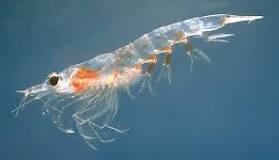
| It turns out, that all life out there depends on this tiny shrimp like creature, who in turn feeds on algae, plankton and invisible, microscopic organisms. |
Though I was to learn, it was one of the most important living things there, I definitely hadn’t planned a trip to the Antarctica Continent to see a mini shrimp.
But, let’s start at the beginning…My cousin casually asked “Wouldn’t it be great to go to Antarctica?”, and my sister, niece and I jumped all over the idea. And before you could say “Penguin!”, the four of us were planning a trip.
As we went about making enquiries and getting pricings, my enthusiasm started waning. Was I ready for this kind of expense? But in the end, I figured, with global warming and an increasing environmental threat, tourism to the region might be curtailed once deterioration speeded up. As I got older, would I be fit enough to do a trip? Would there be any ice left?
I must admit, though it was on my wish list, I hadn’t imagined I’d be planning a trip so soon.
But as I read more, and thought, about it, – a new continent , it’s unique landscape – endless snow covered mountains, active volcanoes, glaciers and icebergs, a land natural and uninhabited, the Midnight Sun, miles of white desert. And a leisurely cruise to spoil myself. Excitement grew – I made up my mind – I had to experience this. And as I spoke about it with friends, another factor emerged- the Bragging rights!
Getting there is not as simple as booking a flight and getting a visa. It has to be planned well in advance.
For one, it has to be between November and March, the southern summer.
And don’t be fooled by the word “Summer”. Though it is the season of the Midnight Sun, it can also be windy and cold. So pack plenty of thermals and warm clothes – inners and “outers”. (Check the website of your tour operator. It will tell you what to pack, and what equipment they will provide.)
Your flights and port of departure will determine your visa requirements.
A lot of prep and planning ….But it’s amazing to think of a place in this modern world governed by the principle , “in the interest of all mankind that Antarctica shall continue forever to be used exclusively for peaceful purposes and shall not become the scene or object of international discord”! This is actually laid down in the Antarctic Treaty, which was signed in Washington on December 1, 1959.
To honour this, various guidelines and protocols have been put in place to protect this remarkable Continent. There are a number of tour operators who are members of the International Association of Antarctic Tour Operators (IAATO). They are supposed to follow safe and environmentally responsible practices. So, when planning, it’s important to select a tour operator which is IAATO certified, because after all, you want to prevent any damage to this fragile environment and it’s unique ecosystem. And of course, it’s wildlife.
Book early! And don’t forget your camera.
Since we were taking long flights, we decided to take a 2 day break in Buenos Aires. It would give us a chance to see a new city and also provide a buffer in case of any long delays in our flight plan.
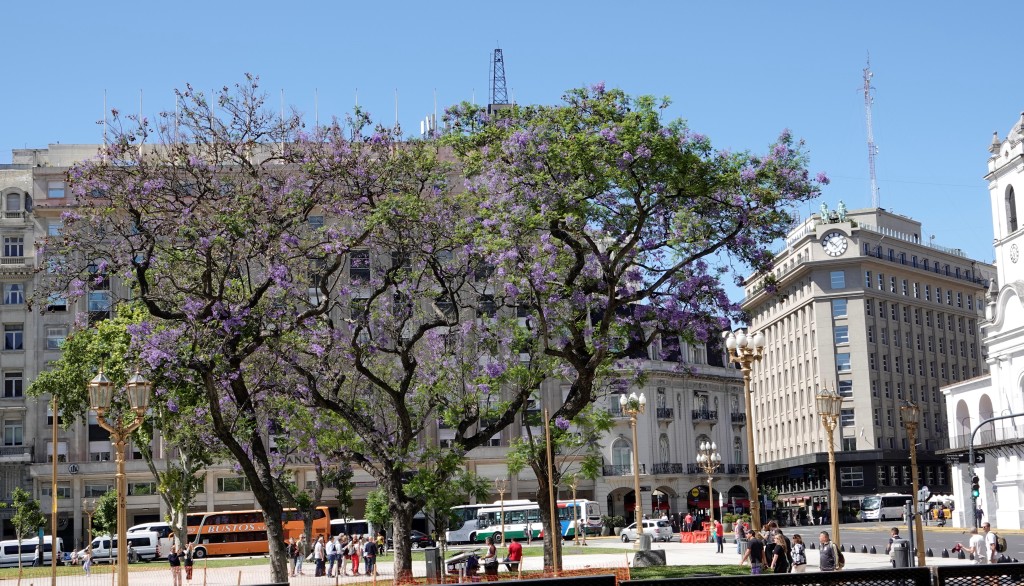
Buenos Aires was delightful. As you know ,or probably guessed, the name means “Good Airs” or “Fair Winds” in Spanish. This was the first time I was visiting South America, so it was all new and exciting.. But this story is about the Antarctica, so I’m not getting into that here…
Buenos Aires was delightful. As you know ,or probably guessed, the name means “Good Airs” or “Fair Winds” in Spanish. This was the first time I was visiting South America, so it was all new and exciting.. But this story is about the Antarctica, so I’m not getting into that here…
We were to board the ship at Ushuaia. A 3 hour flight from Buenos Aires and we were in the Southern Most City in the World. As you arrive at the Ushuaia airport, the excitement starts. You are surrounded by snow capped mountains wherever you go. It’s cold and you can see the bay and your ship and you know you’ll be on your way soon. You can book a day’s pre-cruise tour to see the sights of the last port of South America.

Its location on the Tierra del Fuego archipelago, has given it the nickname, the “End of the World.”
The name “Ushuaia” itself comes from the language of the native Yámana Indians and means “bay that penetrates westward.”
After we boarded the ship, post dinner, we assembled in the auditorium. We had known this was not a normal cruise liner with deck games and casinos. The briefing explained that this was an expedition – that our days would be filled with landings, zodiac cruises, lectures and briefings. “This is NOT a cruise” …. we were warned…. And true to their word the next day’s programme started with us getting kitted in the iconic red wind jacket, getting fitted for the heavy rubber boots they would loan us for the duration of our trip, and more lectures and talks.
To get to Antarctica, you have to sail through one of the roughest seas in the world – The Drake Passage. We had prepared for weeks, stocking up on all kinds of sea sickness pills. Ones that made you drowsy, those that didn’t… ones that were quick acting, those that weren’t… ones that required a prescription, those that didn’t. Between the four of us we had a pharmacy of sorts. And then we hit the dreaded passage and the ship rolled slightly. And we all held our breath. They say there are 2 types of crossings – The Drake Lake and the Drake Shake. And we heaved a sigh of relief – we were lucky to have The Drake Lake and sailed smoothly on the way out, as well as the way back. (And now we have plenty of travel sickness tablets to last a lifetime – or till their expiry). But I have heard many tales of the Drake Shake and I suggest you prepare for the worst. One of the distractions I would recommend is spending time on the deck. The air is clean and cold, and windy -so bundle up. But it is exhilarating to get away from land. Sea as far as the eye can see. And if you have a good camera, you might capture some birds.

During breakfast on the second day, an excited shout – ICEBERG! We all rushed on to the deck . And there was what we were all waiting to see! Our first!
And then a few hours later we were in a Magical Land of White! And blue! Ice everywhere!
What struck me most was the silence. And absolutely no trace of humans! Throughout the trip, I spent a lot of time on the deck. It seemed such a waste to go inside when you had this view outside.
We soon settled into a routine. Meals of course were important – with terrific food. (But if you’re a vegetarian on a Norwegian ship, I feel a bit sorry for you if you don’t like salads!)
Plenty to do. Remember, “This is NOT a cruise!”. One landing a day, which one had to gear up for – innerwear, outerwear, jackets, windcheater, lifevest, boots (insist on the correct size and fit or you’re going to hobble along the treks – advice from painful firsthand experience). It took a lot of time to get ready for an outing. A short ride in the zodiac, and then – the thrill of standing on the Ice Continent! For the fit there was a short trek. Though there were very few youngsters, most people were in good shape and completed the trek. What we soon learnt was that if there is no wind, it can get surprisingly hot and sweaty under the wind jacket, so layer and be prepared to shed!
Landing locations with penguin nesting sites were selected, so we had a lot of entertainment. Penguins are funny, noisy and constantly on the move – either going down to the water, or roaming around the colony stealing stones from others’ to bring back to their nesting lady, constantly bickering and complaining about the theft. They create a path, or penguin highway , through the snow from the nesting grounds to the sea. Also, you can smell these colonies from afar. Penguin poo is powerful and red! And you see red everywhere a penguin has been – the colony, the highways, on themselves, everywhere. And that’s where we come to learn the importance, and the power, of Krill! The penguin diet consists of these little pink creatures and that evidence is seen everywhere. And smelt! I’ve been told you can see the red krill poo from space….

Which brings us back to the Krill – a small creature that makes a giant size contribution to the South seas and the fragile ecosystem and wildlife of the Antarctica.
Here, the entire food chain is dependent on Krill. Either it is eaten directly. Or indirectly – by creatures that eat the krill-eaters!
Every year, over half of the krill in the Antarctic is consumed by whales, seals, penguins and birds. They are essential for all life here. Now, imagine for a moment that the most substantial food source disappeared!
Those who depend on krill cannot always move to another area. Penguins in particular cannot travel too far from their nests in search of food when raising chicks. Also, some species like the Chinstrap and Adelie, consist on a diet solely made up of krill.
Krill themselves feed on phytoplankton and are found in swarms of millions or even billions. Krill also like to feed on the algae that accumulates under sea ice. The waters of the Southern Ocean around Antarctica are ideal, since they are exceptionally rich sources of phytoplankton and algae.
However, sea ice cover is not constant around Antarctica, leading to fluctuations in krill populations. The West Antarctic Peninsula, which is one of the most rapidly warming areas in the world, has experienced a measurable loss of sea ice over the past few years. And studies show that there has been a drop in krill stocks.
Industrial fishing of krill, has also played its part in this decline. Further North, harvesting them in the millions for omega-3 pills, pet food, fish bait, and the latest cosmetic fad – anti-ageing Krill oil.
Fortunately, there are now initiatives to protect them. Each creature on its own is tiny, but their presence is massively important to this region. It is crucial that we protect the Krill to save the future generations of wildlife in the Antarctic.
Blue and humpback whales migrate to the Antarctic from warmer waters every year just to feast on krill. Blue whales can eat up to 4 tons of krill per day, and other baleen whales can also consume thousands of pounds of krill daily. Another dependant of krill are the Minke whales.


The Orcas made a brief appearance one evening, but only on the horizon. We did see some seals that had injuries – probably from Orca attacks.
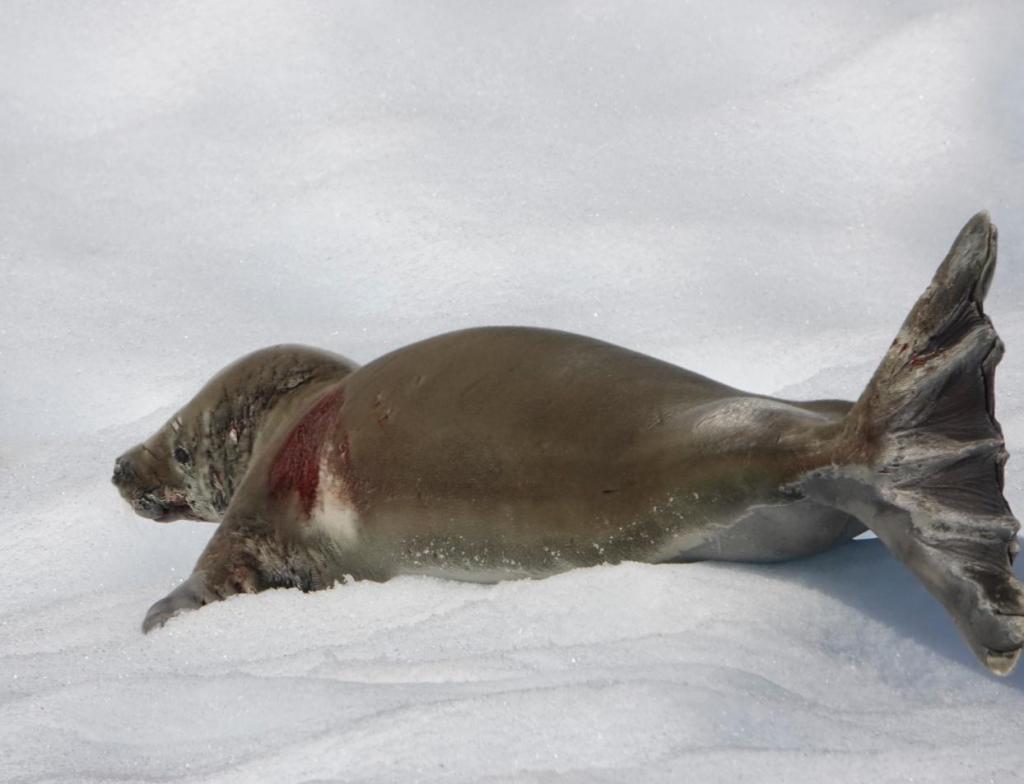
One of the landing sites was Deception Island at Whalers bay. A ring-shaped island was formed when the volcano had collapsed into itself forming the caldera (or cauldron), leaving a circular ridge above the sea . This is an active volcano and there are hot springs on the beach. In the steaming waters we saw some boiled krill, which must have provided a break from the regular diet of raw krill, and the skuas and penguins were having a feast.

There were always a lot of birds near the penguin sites, since the birds, usually swooping skuas, try and get to the eggs
Standing on the lava of a live volcano should have been thrilling, but we were surrounded by the grim reminder of what happened during the early years when blubber was much sought after. The abandoned storage tanks stand testament to the carnage that must have taken place, when these huge vats were filled with seal and whale fat.

The whaling industry might have lit many street lights and homes and also oiled the wheels of the Industrial revolution, which kickstarted large scale technical advancements around the world, but we still haven’t recovered from the damage we did to the population of whales. And unfortunately, there are still countries that continue to hunt them.
As always, the Expedition Team members accompanying us, apart from making sure we got in and out of the zodiac safely, were a wealth of information. They also ensured that we left the place as we found it – free of signs of human intrusion.
Most afternoons were spent Cruising , which was delightful. The zodiacs would scoot around the bay, taking us up close to fantastical icebergs and caves carved in the ice.
It felt like you’d fallen into a giant blue Curacao cocktail, surrounded by crushed ice and ice cubes
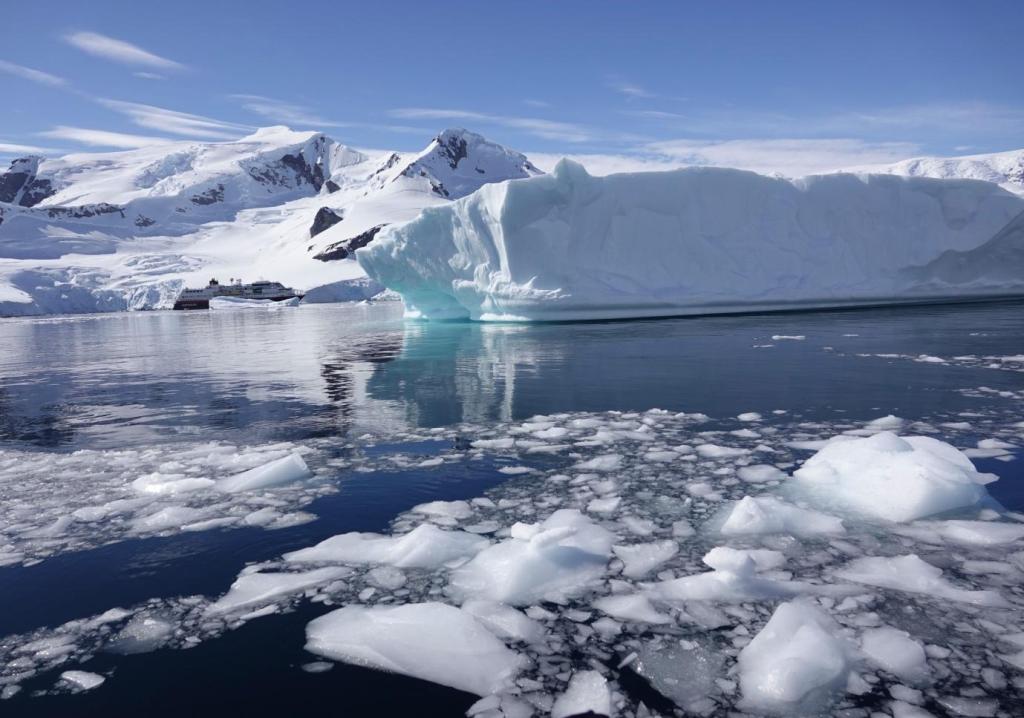
The other optional activities on offer was camping on the ice for the night. One of the campers told me how disconcerting it was to pee in a bucket with a couple of penguins eyeing you curiously!
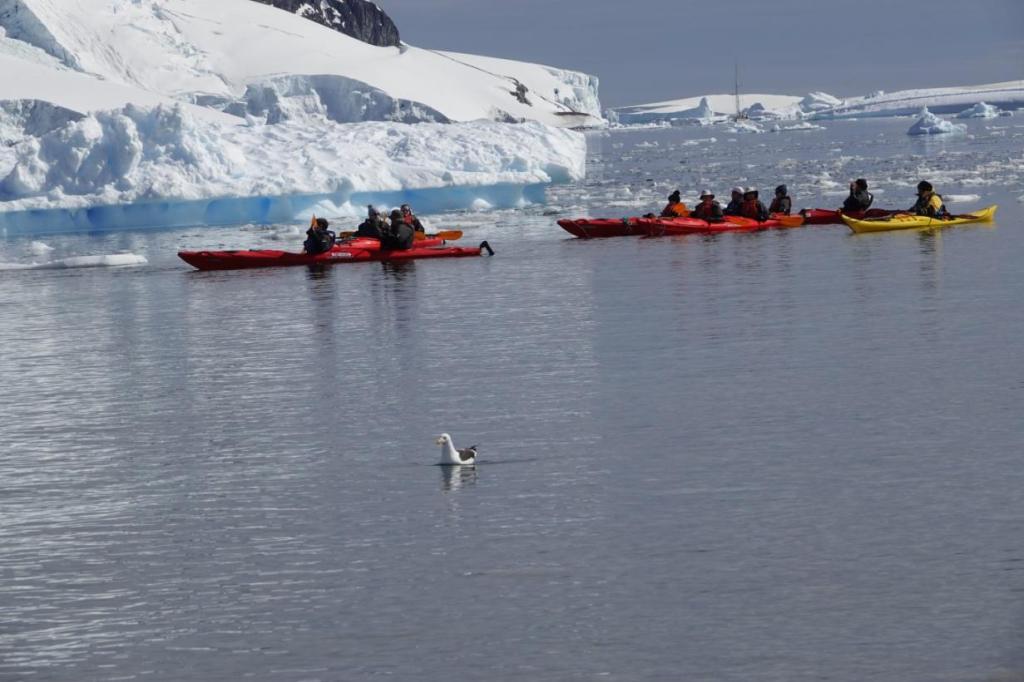
Kayaking
Snowshoeing
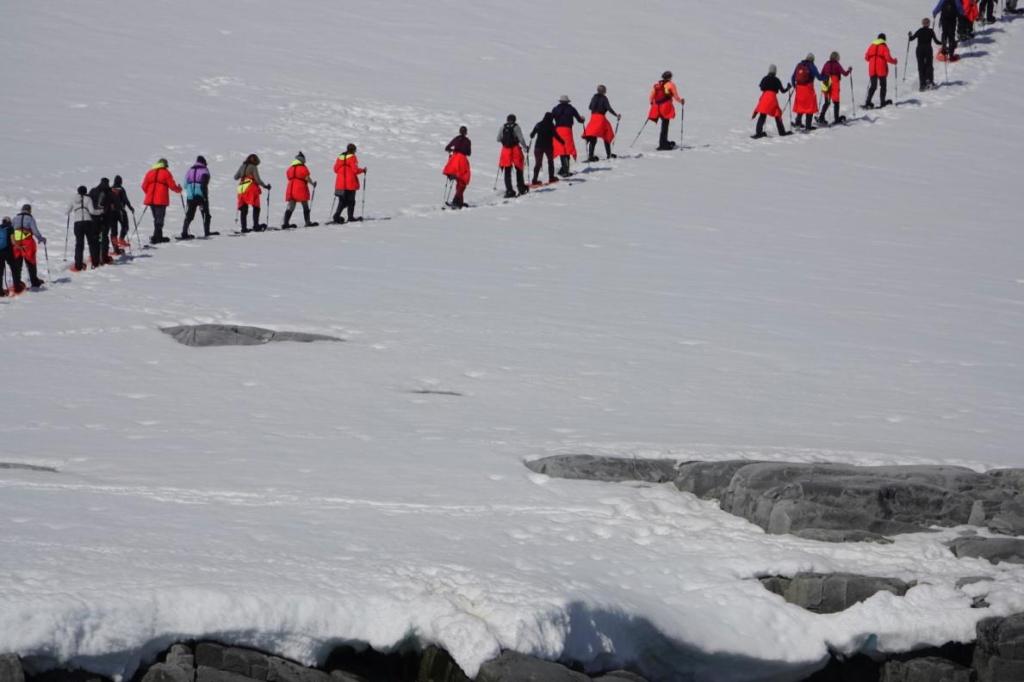

Arctic plunge for the brave
As we tracked our path on the map, we come across many new and unusual sounding names that we’d never heard before – Gerlache , Danco, Lemaire, Skotorp, and more. One usually hears of South Pole expeditions led by the English Naval Officer Scott and the Norwegian explorer Amundsen, but one knew very little about all these other intrepid, brave men (unfortunately no women mentioned) who set out to find the Pole and in the harshest and cruellest conditions. Many lost their lives, but for them adventure and exploration were above everything.
Of course, the ones who first came to this Frozen Continent, came for the more material reason – Profit. These were the whalers and sealers who came for the blubber for fuel (Remember those horrid vats on Deception Island?), whalebone for corsets, fur for clothing . But the explorers that followed, undertook these expeditions in attempts to penetrate further into the interior of the continent , to find the South Pole.
We had many interesting lectures on board, but by far the ones enjoyed most were about the explorers and their stories. Dr. Carol, the expedition historian, through her skilled storytelling shared some fascinating accounts of these men and brought their adventures to life . The story that stayed with us was the one about 2 very young men (boys really) who wintered on the Continent on their own. After attending her lectures, my niece and I were hooked and Carol helped us with a bibliography so we can continue our exploration of the Antarctica and it’s heroes for many years to come, from home.
Here I must add, all the members of the expedition team were fantastic. Their lectures were informative. And they themselves were helpful, friendly and enthusiastic. Not just in their guest relation skills, but their passion for their work and areas of research – be it telling the history of the Continent, or be it dog handling, or studying the wildlife and marine plants, or the effects of global warming, and of course, the Krill. I feel that I could go so far as to say these men and women were actually following in the footsteps of the 20th Century explorers – except that this time it was not to discover the continent, but to save it.

The Antarctic Ice Sheet extends almost 14 million square kilometers (5.4 million square miles), roughly the area of the contiguous United States and Mexico combined. It contains 30 million cubic kilometers (7.2 million cubic miles) of ice.
https://nsidc.org/cryosphere/quickfacts/icesheets.html (for those of you interested in figures)
The Ice sheet is formed when snow, which never melts, compacts under fresh snow every winter, creating dense layers.
These are constantly in motion, moving downwards towards the sea, where they form a shelf, or break off, calve, to float away as icebergs and smaller flows.

How is Global Warming going to impact this region? Warm winds blowing on the surface, melt more snow which doesn’t get a chance to re-freeze, and warm currents cutting into the ice shelf also melt more ice than ever before. The slowly shrinking sheet is now a victim of climate change. And it’s important to study the impact on this area and find ways to prevent wide spread damage and destruction before we lose it altogether.
Back home now, what I remember most about this driest and coldest Continent on earth, is the spectacular scenes of ice, sea and mountains, a landscape few have had the opportunity to enjoy. So isolated and splendid. And definitely worth fighting to save.

